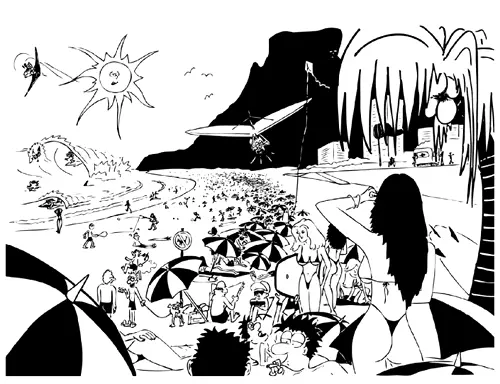Carioca menus tend to be lengthy, often four to six pages long, and due to fluctuating costs, the prices are either handwritten in pencil or typed on strips of paper, which are then pasted over the previous prices. The beauty of the Carioca restaurant is that, regardless of the menu, you can usually have any dish you want, prepared in whichever manner tickles your fancy, accompanied by whatever is available in the kitchen.
No matter how hard the Carioca waiter tries to please you, though, there are certain dishes you won’t find on any Carioca menu (unless, perhaps, you check into a five star hotel). For example:
• tuna on white
• macaroni and cheese
• lemon chiffon pie
• cottage cheese with peaches
• root beer
• two eggs, over easy, with hash browns
• bologna on rye
• Reuben sandwich
• blueberry cheese cake
• Thousand Island dressing
• decaffeinated coffee
• buckwheat pancakes with your choice of syrup
In compensation, though, you might discover some other exotic dishes on the bilingual menus, which you’ll find in the finer food establishments, conveniently available for their English speaking patrons.
Carne Desfiada com Molho de Ervilhas
(Meat Unwoven with Pea Cream)
Frango Alemão(Chicken at Germany Mood)
Filet ao Molho Madeira(Steak with Wooden Sauce)
Arroz à Grega(Grease Rice)
Filet à Cavalo (Steak Riding a Horse)
Frango com Purê de Batata(Chicken with Smashed Potatoes)
Pickles (Olivers)

What you will find in a carioca restaurant
Purple phosphorescent fl у zappers.
A sink in the back of the dining area with an accordion stack of coarse paper towels for drying hands.
Small wooden, hard-back chairs with one leg inevitably shorter than the others.
Creative, plastic-covered bilingual menus at least six pages long. Rest rooms with the initial «S» on both doors, accompanied by a subtle, indecipherable drawing.
Well-meaning waiters who seem to have inherited their white jackets from slimmer predecessors.
Well-used, two-sided tablecloths, sometimes accompanied by a plastic or paper covering.
Tables with matchboxes under one leg to balance them.
An occasional cockroach.
Forks with bent prongs.
What you won’t find in a carioca restaurant
Cloth place mats.
Waitresses wearing white dresses and aprons saying, «Have a nice day.»
Waiters who identify themselves by saying, «Hi, I’m Brian, and I will be your server today.»
Waiters informing you of the «Catch of the Day.»
Fresh baked pies and gelatin desserts displayed in glass cases. Bills inscribed with «Please pay at register.»
Menus from which you order by the number.
A nonsmoking section (without smokers smoking).
Lesson 10
The Carioca Summer
Those summer months in Rio, from September to May, are very popular because of all the available activities and the hot, humid weather. Summer also seems to bring out the inherent passion that lives inside all Cariocas, so the days when the thermometers reach 44 °C (that’s about in°F, folks) are not really that bad-as long as you know what to do and what not to do.
What to do:
• Go to the beach
• Sit in an air-conditioned room
• Drink choppsat the boteco
• Wear a tangaor sungaall day
• Go to an air-conditioned motel
What NOT to do:
• Go to work
• Walk downtown
• Drive during rush hour
• Shop in Copacabana
• Wear much clothing
If you think that going to the beach is simply a matter of putting on a bathing suit, grabbing a towel, and heading for the nearest stretch of white sand to bag a few rays, think again. To the Carioca, going to the beach is an art form.
Before venturing out, be sure to refer back to Lesson 6 to ensure you are dressed (or undressed) appropriately. Then check your newspaper to see if the health authorities have liberated your favorite beach for swimming. Being a Carioca, ignore the warnings; but once your are there, do look out for:
• pivetesand ratos de praia
• fishing lines
• bugs that you can see and that bite
• bugs that you can’t see and that bite
• UFOs (Unidentified Floating Objects)
• IFOs (Identified Floating Objects)
• dog mines
When in Rio, it is absolutely imperative that you go to the beach like a true Carioca. If you resort to your usual habits, you will definitely be labeled a tourist. Therefore, memorize the following thirteen easy Steps on how to conduct yourself once you have arrived AT the beach. Remember! Your status as a Carioca will depend on it.
Step 1. Parking:When arriving by car you will naturally be met by a flanelinha, with the exception that here he will be weaving not only a flag; he will be flapping a piece of cardboard at you while directing you to the nearest parking space. The cardboard is to cover your windshield so that you won’t burn your fingers on the steering wheel after it bakes in the hot sun. Clever, no? Insist that the cardboard isn’t necessary, and he will put one on your car anyway. Be sure to carry the appropriate change for him. But before leaving your vehicle in his care, be sure to say:
«Te pago na volta, mermão.» [tchee ’pah goh nah ’vohl tah merh ’mown]: «I’ll pay you later, buddy.»
Step 2. Collecting your paraphernalia:A true Carioca will always carry beach chairs, an umbrella, esteiras[eh ’shtay rrahs] (straw mats), and other beach paraphernalia in the trunk of his car. That way, no matter where he is, he will be prepared to stop what he is doing and hit the beach. (Of course, wearing beach attire from morning until the sun goes down always facilitates matters when the beach is calling.)
Step 3. Deciding where to sit:In the process of developing your new status as a Carioca, where you settle on the beach is of utmost importance. Sitting close to a beer vendor guarantees that your cervasand your água com gás[’ah gwah kown ’gaiysh] (water with gas) will be delivered ice cold, and you won’t have to move from your spot when it comes time to order the next round. Avoid sitting next to the sewers or too close to the water. It is very embarrassing when a wave washes away your belongings, and it could even trigger an early departure from the beach. Of course, sitting close to the sidewalk where the sand is the hottest you run the risk of burning your feet going to and from the water. When sitting near the sidewalk on São Conrado beach, there also exists the added excitement of hang gliders landing on top of you.

If in doubt, just check where the other Cariocas are, mark your spot, and join the crowd.
Step 4. Setting up your umbrella:To properly set up your guarda sol(beach umbrella), take the bottom half of the pole and stab it into the sand as hard as you can. Be sure to pay close attention to the direction of the sun to avoid repeating the entire process. Then rotate the pole in a counterclockwise motion, as if you were stirring a large pot of beans. Once it is securely buried — at least twenty centimeters in the sand — you are then ready to attach the top portion of your umbrella. (Reserve at least five minutes for this process. If you don’t bury the pole sufficiently, it will fly away with the first gust of wind.)
Читать дальше














